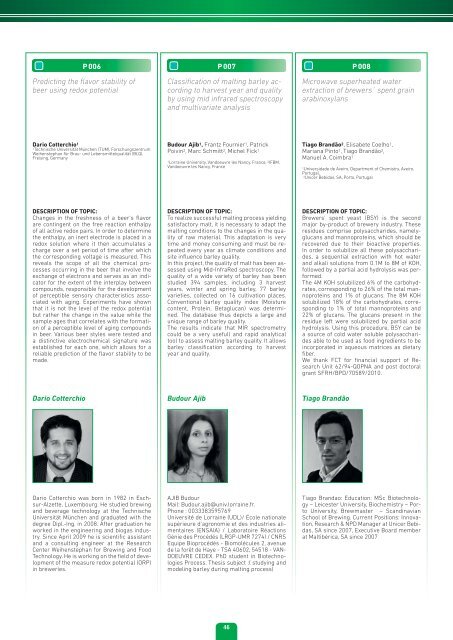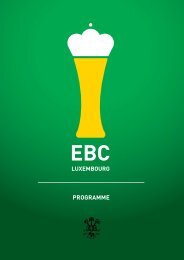please click here for download. - the 34th European Brewery ...
please click here for download. - the 34th European Brewery ...
please click here for download. - the 34th European Brewery ...
You also want an ePaper? Increase the reach of your titles
YUMPU automatically turns print PDFs into web optimized ePapers that Google loves.
P 006<br />
Predicting <strong>the</strong> flavor stability of<br />
beer using redox potential<br />
P 007<br />
Classification of malting barley according<br />
to harvest year and quality<br />
by using mid infrared spectroscopy<br />
and multivariate analysis<br />
P 008<br />
Microwave superheated water<br />
extraction of brewers´ spent grain<br />
arabinoxylans<br />
Dario Cotterchio 1<br />
1Technische Universität München (TUM), Forschungszentrum<br />
Weihenstephan für Brau- und Lebensmittelqualität (BLQ),<br />
Freising, Germany<br />
Budour Ajib 1 , Frantz Fournier 1 , Patrick<br />
Poivin 2 , Marc Schmitt 2 , Michel Fick 1<br />
1Lorraine University, Vandoeuvre les Nancy, France, 2 IFBM,<br />
Vandoeuvre les Nancy, France<br />
Tiago Brandão 2 , Elisabete Coelho 1 ,<br />
Mariana Pinto 1 , Tiago Brandão 2 ,<br />
Manuel A. Coimbra 1<br />
1Universidade de Aveiro, Department of Chemistry, Aveiro,<br />
Portugal,<br />
2Unicer Bebidas, SA, Porto, Portugal<br />
DESCRIPTION OF TOPIC:<br />
Changes in <strong>the</strong> freshness of a beer‘s flavor<br />
are contingent on <strong>the</strong> free reaction enthalpy<br />
of all active redox pairs. In order to determine<br />
<strong>the</strong> enthalpy, an inert electrode is placed in a<br />
redox solution w<strong>here</strong> it <strong>the</strong>n accumulates a<br />
charge over a set period of time after which<br />
<strong>the</strong> corresponding voltage is measured. This<br />
reveals <strong>the</strong> scope of all <strong>the</strong> chemical processes<br />
occurring in <strong>the</strong> beer that involve <strong>the</strong><br />
exchange of electrons and serves as an indicator<br />
<strong>for</strong> <strong>the</strong> extent of <strong>the</strong> interplay between<br />
compounds, responsible <strong>for</strong> <strong>the</strong> development<br />
of perceptible sensory characteristics associated<br />
with aging. Experiments have shown<br />
that it is not <strong>the</strong> level of <strong>the</strong> redox potential<br />
but ra<strong>the</strong>r <strong>the</strong> change in <strong>the</strong> value while <strong>the</strong><br />
sample ages that correlates with <strong>the</strong> <strong>for</strong>mation<br />
of a perceptible level of aging compounds<br />
in beer. Various beer styles were tested and<br />
a distinctive electrochemical signature was<br />
established <strong>for</strong> each one, which allows <strong>for</strong> a<br />
reliable prediction of <strong>the</strong> flavor stability to be<br />
made.<br />
DESCRIPTION OF TOPIC:<br />
To realize successful malting process yielding<br />
satisfactory malt, it is necessary to adapt <strong>the</strong><br />
malting conditions to <strong>the</strong> changes in <strong>the</strong> quality<br />
of raw material. This adaptation is very<br />
time and money consuming and must be repeated<br />
every year as climate conditions and<br />
site influence barley quality.<br />
In this project, <strong>the</strong> quality of malt has been assessed<br />
using Mid-InfraRed spectroscopy. The<br />
quality of a wide variety of barley has been<br />
studied 394 samples, including 3 harvest<br />
years, winter and spring barley, 77 barley<br />
varieties, collected on 16 cultivation places.<br />
Conventional barley quality index (Moisture<br />
content, Protein, Betaglucan) was determined.<br />
The database thus depicts a large and<br />
unique range of barley quality.<br />
The results indicate that MIR spectrometry<br />
could be a very usefull and rapid analytical<br />
tool to assess malting barley quality. It allows<br />
barley classification according to harvest<br />
year and quality.<br />
DESCRIPTION OF TOPIC:<br />
Brewers‘ spent yeast (BSY) is <strong>the</strong> second<br />
major by-product of brewery industry. These<br />
residues comprise polysaccharides, namelyglucans<br />
and mannoproteins, which should be<br />
recovered due to <strong>the</strong>ir bioactive properties.<br />
In order to solubilize all <strong>the</strong>se polysaccharides,<br />
a sequential extraction with hot water<br />
and alkali solutions from 0.1M to 8M of KOH,<br />
followed by a partial acid hydrolysis was per<strong>for</strong>med.<br />
The 4M KOH solubilized 6% of <strong>the</strong> carbohydrates,<br />
corresponding to 26% of <strong>the</strong> total mannoproteins<br />
and 1% of glucans. The 8M KOH<br />
solubilized 18% of <strong>the</strong> carbohydrates, corresponding<br />
to 1% of total mannoproteins and<br />
22% of glucans. The glucans present in <strong>the</strong><br />
residue left were solubilized by partial acid<br />
hydrolysis. Using this procedure, BSY can be<br />
a source of cold water soluble polysaccharides<br />
able to be used as food ingredients to be<br />
incorporated in aqueous matrices as dietary<br />
fiber.<br />
We thank FCT <strong>for</strong> financial support of Research<br />
Unit 62/94-QOPNA and post doctoral<br />
grant SFRH/BPD/70589/2010.<br />
Dario Cotterchio<br />
Budour Ajib<br />
Tiago Brandão<br />
Dario Cotterchio was born in 1982 in Eschsur-Alzette,<br />
Luxembourg. He studied brewing<br />
and beverage technology at <strong>the</strong> Technische<br />
Universität München and graduated with <strong>the</strong><br />
degree Dipl.-Ing. in 2008. After graduation he<br />
worked in <strong>the</strong> engineering and biogas industry.<br />
Since April 2009 he is scientific assistant<br />
and a consulting engineer at <strong>the</strong> Research<br />
Center Weihenstephan <strong>for</strong> Brewing and Food<br />
Technology. He is working on <strong>the</strong> field of development<br />
of <strong>the</strong> measure redox potential (ORP)<br />
in breweries.<br />
AJIB Budour<br />
Mail: Budour.ajib@univ.lorraine.fr.<br />
Phone : 0033383595769<br />
Université de Lorraine (UDL)/ École nationale<br />
supérieure d‘agronomie et des industries alimentaires<br />
(ENSAIA) / Laboratoire Réactions<br />
Génie des Procédés (LRGP-UMR 7274) / CNRS<br />
Equipe Bioprocédés - Biomolécules 2, avenue<br />
de la <strong>for</strong>êt de Haye - TSA 40602, 54518 - VAN-<br />
DOEUVRE CEDEX. PhD student in Biotechnologies<br />
Process. Thesis subject :( studying and<br />
modeling barley during malting process)<br />
Tiago Brandao: Education: MSc Biotechnology<br />
– Leicester University, Biochemistry – Porto<br />
University, Brewmaster – Scandinavian<br />
School of Brewing. Current Positions: Innovation,<br />
Research & NPD Manager at Unicer Bebidas,<br />
SA since 2007, Executive Board member<br />
at Maltibérica, SA since 2007<br />
46





